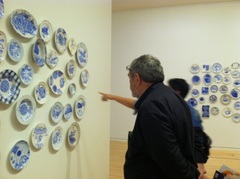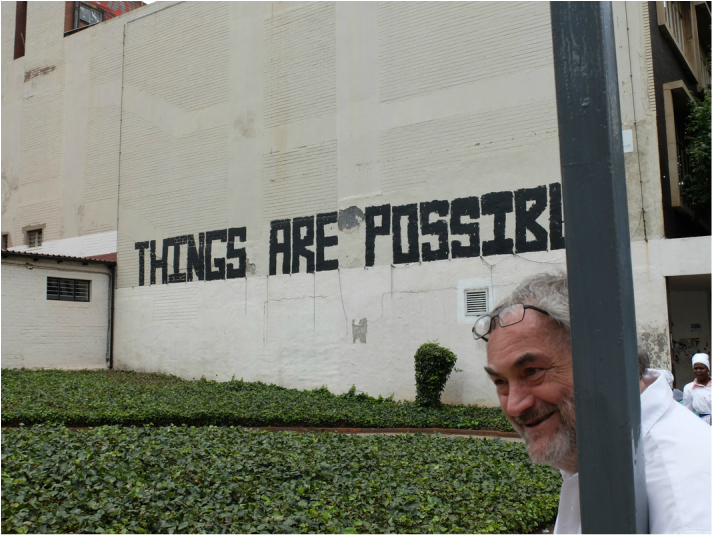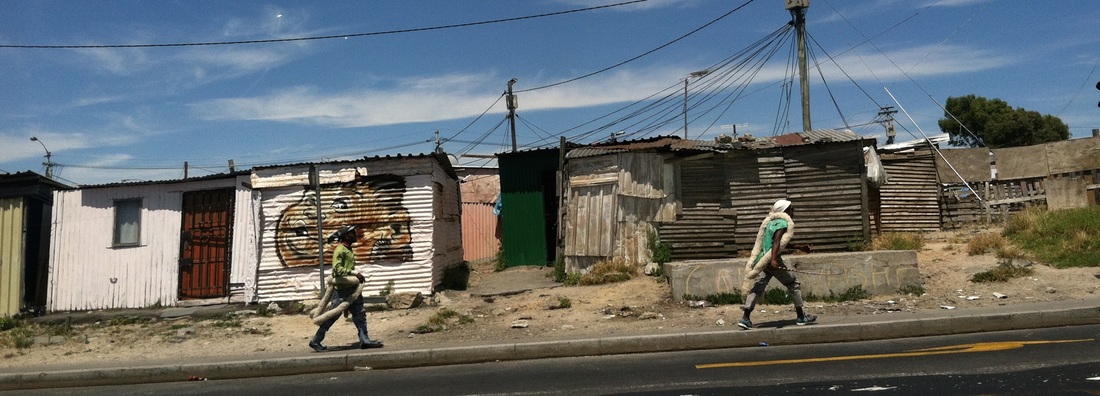In November of 2014 La Follette received an Artist Opportunity grant to travel to South Africa to investigate the next Sites of Passage project. She already had a residency at The Butterfly Art Project to work in a township school program in Cape Town. So she took the opportunity to meet with artist and activists from Cape Town to Johannesburg. This is where she refined her ideas and curated in the South African artists for the project. The new endeavor is called CIVIL RIGHTS & CIVIL WRONGS.
| | La Follette split her time evenly between Johannesburg (Joburgh) and Cape Town. Mbovu Malinga toured her throughout Cape Town, visiting creative projects based in the townships and the city. Malinga, who is a dancer, choreographer and designer is well connected to the social practice side of Cape Town, as well as the "high art" realm. Therefore, he made a great guide for the people and organizations La Follette was seeking out. |
While in Cape Town La Follette also spent time with Angela Katschke and Charlie Jansen at The Butterfly Art Project (http://www.butterflyartproject.org), an art organization run out of one of the schools in a township in Cape Town. Here, La Follette worked closely with Charlie to build super hero puppets with the kids, writing their own stories and inventing new heros to rise from the ashes.
Back in Joburgh, La Follette met up with Malcolm Purkey, who is an actor, director, playwright, drama lecturer, artistic director and currently the Dean of AFDA, The South African School of Motion Picture Medium and Live Performance. He gave La Follette one of his famous " Malcolm cultural tours", introducing her to social activists, artists and cultural leaders. Purkey was the artistic director of Market Theatre, which played a leading role in the anti-apartheid movement. Founded in 1976 in Johannesburg, Market Theatre, has been South Africa’s landmark “Theatre of Struggle” producing anti-apartheid plays, premiering many of Athol Fugard’s. Under “the conviction that culture can chance society”, Purkey took over the theatre as Artistic Director in 2005 and has been an activist in the arts scene ever since. Below Purkey is outside The Nunnery, theatre he founded while in college at University of the Witwatersrand, or Witts University.

In June, with the help of DePaul University, La Follette was able to bring in Malcom Purkey to Chicago to brainstorm ideas, artist, itinerary in South Africa and a longer-term performance project she and Purkey are working on. Purkey visits The Last Supper exhibit by Julie Green in Evanston , where 600 white ceramic plates decorated with cobalt blue mineral paint to depict the last meal requests of U.S. death row inmates. The exhibit questions race, class and justice issues in the US.
WHY NOW?
As the U.S. moves past its 50th year of the Civil/Voters Rights Act and South Africa moves past its 20th year of democracy/post-apartheid, the project will reflect on what we can learn from one another. What have we done wrong and what have we done right? How does migration play a role? How do our governments, communities and societies discern and apply our past to our present? Are environmental rights the same as human rights? What language do we use to talk about these issues? By meeting with civil rights activists, artist and historians from both countries, our aim is to use art as a platform to expose and address environmental racism and corruption.
In recognition of the Voting Right Act of 1965 and in preparation for the Presidential Election of 2016, Civil Rights and Civil Wrongs also aims to interact, educate and activate the next generation of voters. Civil Rights and Civil Wrongs is the third "site of passage" project. Each time we learn more and connect more artists. Once a tunnel of communication is digitally dug from one country to the next, we do not close it – we connect it. We hope to eventually build a global network of artists via Sites of Passage (SOP), the name all these projects now fall under.
WHY NOW?
As the U.S. moves past its 50th year of the Civil/Voters Rights Act and South Africa moves past its 20th year of democracy/post-apartheid, the project will reflect on what we can learn from one another. What have we done wrong and what have we done right? How does migration play a role? How do our governments, communities and societies discern and apply our past to our present? Are environmental rights the same as human rights? What language do we use to talk about these issues? By meeting with civil rights activists, artist and historians from both countries, our aim is to use art as a platform to expose and address environmental racism and corruption.
In recognition of the Voting Right Act of 1965 and in preparation for the Presidential Election of 2016, Civil Rights and Civil Wrongs also aims to interact, educate and activate the next generation of voters. Civil Rights and Civil Wrongs is the third "site of passage" project. Each time we learn more and connect more artists. Once a tunnel of communication is digitally dug from one country to the next, we do not close it – we connect it. We hope to eventually build a global network of artists via Sites of Passage (SOP), the name all these projects now fall under.
The purpose of the proposed project is to flush away hyperbole and clichés from the work. Although we want to reflect on our various governments and leaders (SA and USA)--we are not interested in embroidering platitudes of the same old conversations. We are concerned with exploring symbols, culture and repetitions in the human condition.


 RSS Feed
RSS Feed